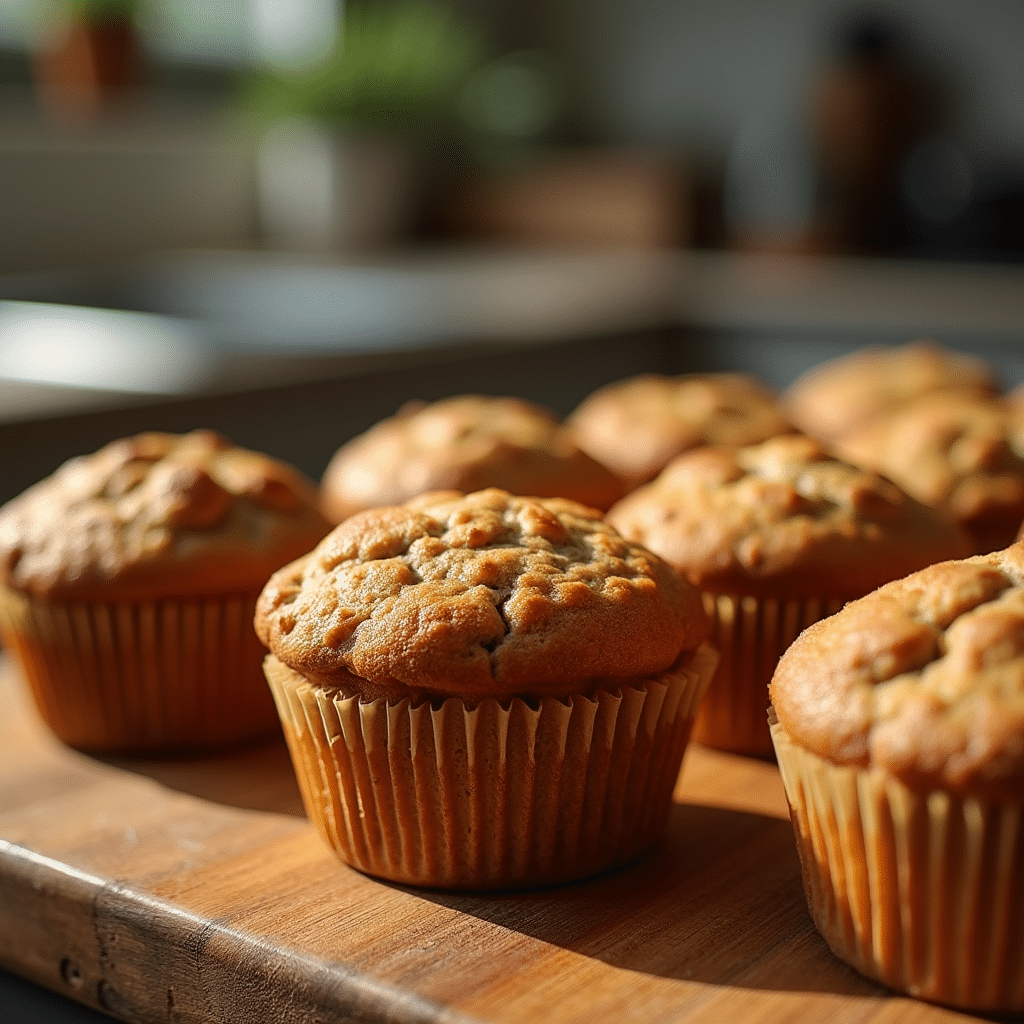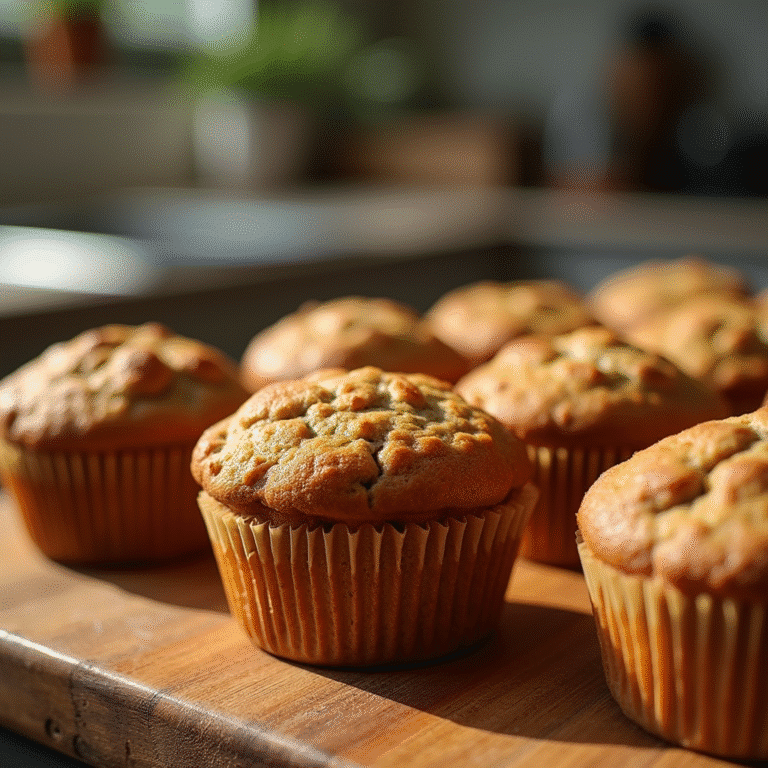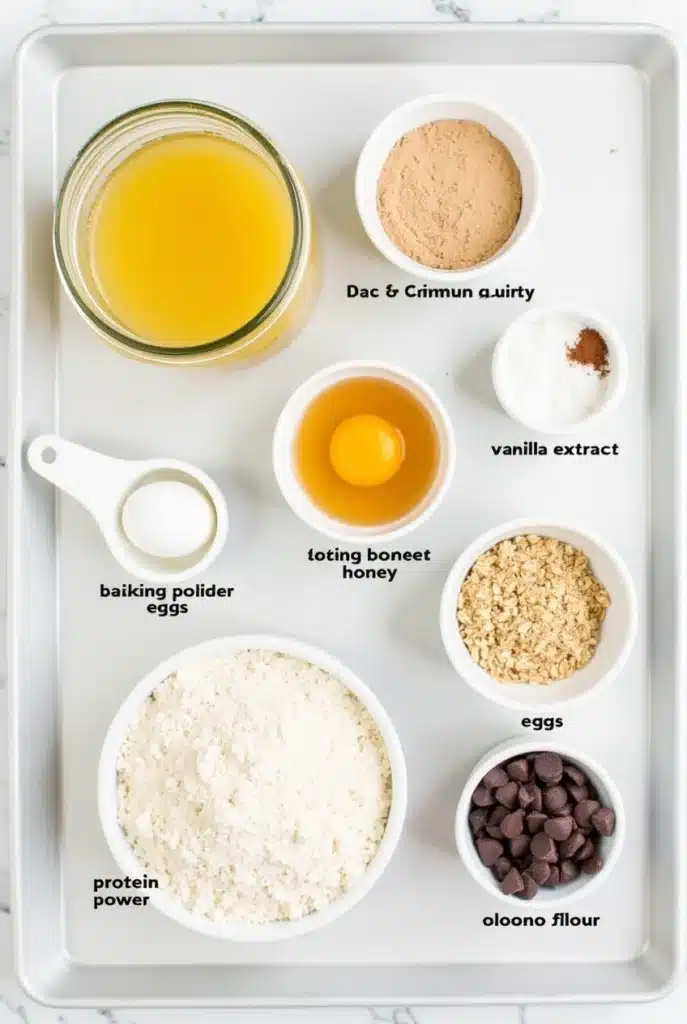If you’re hunting for a quick, healthy, and high-protein snack, banana protein muffins are your new best friend. Packed with natural sweetness from ripe bananas and boosted with the protein punch of your favorite powder, these muffins hit that sweet spot between indulgence and nourishment. Whether you’re into fitness, trying to eat clean, or just need an easy grab-and-go breakfast, banana protein muffins deliver taste and nutrients in one bite.

Not only are they easy to bake, but they’re also endlessly customizable—gluten-free, dairy-free, or vegan? You’ve got options. In this guide, we’ll cover everything you need to know about baking the perfect banana protein muffin, from choosing the right ingredients to storing them for busy weeks.
.
Table of Contents

Banana Protein Muffins – The Best High-Protein Snack You’ll Love
moist, high-protein snack made with ripe bananas, protein powder, and healthy ingredients—perfect for meal prep, breakfast, or workouts.
- Total Time: 30 minutes
Ingredients
2 ripe bananas (mashed)
2 eggs (or flax eggs)
1/2 cup Greek yogurt
1 scoop protein powder (25g)
1 cup oat flour
1 tsp baking powder
1/2 tsp baking soda
1/2 tsp cinnamon
1 tsp vanilla extract
1–2 tbsp maple syrup (optional)
Instructions
Preheat oven to 350°F. Line muffin tin.
Mash bananas and mix with wet ingredients.
In another bowl, whisk dry ingredients.
Combine wet and dry, stir gently.
Fill muffin cups 3/4 full.
Bake 18–22 min. Cool before storing.
Notes
Wrap individually, freeze up to 3 months, label for freshness
- Prep Time: 10 minutes
- Cook Time: 20 minutes
- Category: Breakfast
- Method: Baking
- Cuisine: American
Nutrition
- Serving Size: 10–12 muffins
- Calories: 170 kcal
- Fat: 8g
- Carbohydrates: 12g
- Protein: 10g
Why Banana Protein Muffins Are the Ultimate Healthy Snack
What Makes Banana Protein Muffins Nutritious?
Banana protein muffins aren’t your average baked good. They combine complex carbs, natural sugars, and lean protein, making them ideal for balancing blood sugar and keeping hunger in check. Bananas are loaded with potassium and vitamin B6, while protein powder helps with muscle repair and energy stability.
Here’s a quick breakdown of their core nutritional benefits:
| Ingredient | Benefits |
|---|---|
| Bananas | Natural sweetness, potassium, fiber |
| Protein Powder | Muscle building, satiety, low sugar content |
| Eggs (or flax eggs) | Protein, healthy fats, structure |
| Oats or flour | Fiber, slow-digesting carbs |
| Greek yogurt | Extra protein, creamy texture |
Benefits of Adding Protein Powder to Muffins
Adding protein powder into banana muffins is a smart way to increase protein intake without adding extra cooking time or complexity. Here’s why it works so well:
- Boosts fullness: Keeps you satisfied longer
- Supports fitness goals: Great for pre/post-workout snacks
- Easy to digest: Especially with plant-based or whey isolate powders
- Customizable nutrition: Adjust flavor and macros with different powders
Choosing the right protein powder can make or break your muffins. Some powders absorb more liquid than others, so it’s important to understand their behavior when baked.
Let’s compare:
| Type of Protein | Texture in Muffins | Best Use Case |
|---|---|---|
| Whey Isolate | Light, fluffy | General use, quick baking |
| Casein | Thick, rich | Moist muffins, extended satiety |
| Plant-Based (Pea, Rice, etc.) | Dense, hearty | Vegan or dairy-free diets |
| Collagen | Slightly chewy | Supports skin/joint health |
Pro Tip: Blend your protein powder with a small amount of liquid before mixing into the batter to prevent clumps and dry spots.
Discover great ideas like Blueberry Protein Muffins if you’re looking to switch up the base fruit without sacrificing taste or nutrients.

Step-by-Step Recipe for Banana Protein Muffins
Prepping the Ingredients and Substitutions
Before you preheat that oven, it’s essential to prep all your ingredients and line up substitutions if needed. This way, you’ll avoid common mistakes and keep the process smooth.
Here’s your essential ingredients list:
- 2 ripe bananas (mashed)
- 2 large eggs (or flax eggs for vegan)
- 1/2 cup Greek yogurt (or coconut yogurt)
- 1 scoop (25g) vanilla or unflavored protein powder
- 1 cup oat flour (or whole wheat flour)
- 1 tsp baking powder
- 1/2 tsp baking soda
- 1/2 tsp cinnamon
- Pinch of salt
- 1–2 tbsp maple syrup or honey (optional, depending on banana ripeness)
- 1 tsp vanilla extract
- Optional mix-ins: dark chocolate chips, chopped walnuts, or chia seeds
Substitution Ideas:
| Ingredient | Substitute Option |
|---|---|
| Greek Yogurt | Dairy-free yogurt, mashed avocado |
| Eggs | 2 flax eggs (2 tbsp flax + 5 tbsp water) |
| Oat Flour | Almond flour (for low-carb) |
| Maple Syrup | Erythritol, monk fruit, or omit |
Tools You’ll Need:
- Mixing bowls
- Muffin tin + paper liners or silicone tray
- Measuring cups and spoons
- Fork or hand blender for banana mash
- Oven preheated to 350°F (175°C)
Baking Instructions and Key Timing Tips for Banana Protein Muffins
Let’s get those muffins into the oven. Here’s the process in easy-to-follow steps:
Step-by-step baking guide:
- Preheat oven to 350°F (175°C). Line or grease your muffin tin.
- Mash bananas in a large bowl until smooth.
- Add wet ingredients: eggs, yogurt, maple syrup, and vanilla extract. Mix well.
- In a separate bowl, whisk together the dry ingredients: oat flour, protein powder, baking powder, baking soda, salt, and cinnamon
- Combine dry into wet and stir until fully mixed (don’t overmix).
- Fold in optional ingredients like chocolate chips or nuts.
- Spoon batter evenly into muffin cups—fill about 3/4 full.
- Bake for 18–22 minutes, or until a toothpick inserted comes out clean.
- Cool muffins in tin for 5 minutes, then transfer to a rack.
Quick Tips:
- Use a cookie scoop for even portioning.
- Avoid overbaking—protein muffins dry out fast.
- Cool completely before storing to prevent sogginess.
Tips to Make Banana Protein Muffins Moist and Fluffy
Common Mistakes and How to Avoid Them
Even seasoned bakers make simple errors when working with protein powder. Since it’s not a traditional baking ingredient, it reacts differently in heat and moisture—meaning your muffins can easily turn dry or dense if you’re not careful.
Here are some common mistakes to avoid:
| Mistake | Impact on Muffins | How to Fix It |
|---|---|---|
| Using too much protein powder | Dry, rubbery texture | Stick to 1 scoop (25g) per 12 muffins |
| Overmixing the batter | Dense, tough muffins | Stir just until combined |
| Not enough moisture | Crumbly, dry results | Add banana, yogurt, or applesauce |
| Skipping leavening agents | Flat muffins | Use baking soda & baking powder combo |
| Baking too long | Dry and cracked tops | Bake 18–22 min max at 350°F |
Pro Tip: Always measure your mashed bananas—1 cup is ideal for adding moisture and natural sweetness.
How to Adjust Texture Based on Protein Powder
Each type of protein powder behaves differently. To get a perfectly fluffy banana protein muffin, slight tweaks go a long way.
Here’s how to adjust based on your choice:
1. Whey Protein
- Tends to create a soft texture, but dries fast.
- Add extra banana or a splash of almond milk to increase moisture.
2. Casein Protein
- Thicker and heavier.
- Reduce the flour by 1/4 cup and slightly increase the baking powder.
3. Plant-Based Protein
- Absorbs more liquid and can be gritty.
- Add oil or yogurt, and let the batter sit for 5 minutes before baking.
4. Collagen Peptides
- Doesn’t thicken much, bakes differently.
- Combine with flour carefully and avoid using it as the only powder.
Bonus Tricks:
- Sift protein powder and flour before mixing for better texture.
- Use silicone muffin liners to trap steam and retain softness.
- Let the batter rest for 5–10 minutes before baking to allow the dry ingredients to fully hydrate.

How to Store and Meal Prep Banana Protein Muffins
Storage Tips: Fridge, Freezer & Reheating Banana Protein Muffins
One of the best things about banana protein muffins is how well they store. Whether you’re baking a batch for the week or freezing extras for later, proper storage is key to maintaining flavor and texture.
Here’s how to store them the right way:
| Storage Method | Duration | Instructions |
|---|---|---|
| Countertop | 1–2 days | Keep in an airtight container; ideal for short-term snacking |
| Refrigerator | 5–7 days | Use sealed containers or wrap individually in plastic wrap |
| Freezer | Up to 3 months | Wrap each muffin in foil or parchment, then store in a zip-top freezer bag |
Reheating Tips:
- Microwave: 15–20 seconds for a soft, just-baked texture
- Oven: Preheat to 300°F and warm for 8–10 minutes
- Toaster Oven: Great for crisping the top while keeping the inside moist
Pro Tip: Always let muffins cool completely before refrigerating or freezing to avoid condensation and sogginess.
Batch Cooking for Weekly Meal Planning
Meal prepping banana protein muffins can save you tons of time during hectic weeks—especially if you’re aiming for a healthier breakfast or post-workout snack.
Steps to Meal Prep Efficiently:
- Bake a double batch on the weekend.
- Let them cool completely on a wire rack.
- Freeze in pre-portioned bags (2 or 3 per bag).
- Label bags with the date to track freshness.
- Thaw overnight in the fridge or reheat from frozen.
Perfect Times to Meal Prep Muffins:
| Day of the Week | Best Use Case |
|---|---|
| Sunday | Weekly breakfast & snack prep |
| Friday | Prepping for weekend travel |
| Midweek | Refill snack stash |
Add-On Meal Prep Tip: Pair muffins with a hard-boiled egg or a protein shake for a complete on-the-go breakfast.
Customizing Banana Protein Muffins for Every Diet
Gluten-Free, Dairy-Free, and Vegan Options
Banana protein muffins are incredibly flexible and can be adapted to suit virtually any diet without sacrificing flavor or texture.
Here’s how to make them work for different needs:
1. Gluten-Free Banana Protein Muffins
- Flour Swap: Use oat flour, almond flour, or a certified gluten-free baking blend.
- Baking Tip: Almond flour adds moisture, while oat flour keeps it hearty.
- Watch For: Hidden gluten in baking powders—always check labels.
2. Dairy-Free Banana Protein Muffins
- Yogurt Substitute: Use coconut yogurt, almond yogurt, or soy-based alternatives.
- Protein Powder : Opt for a dairy-free, plant-based protein such as pea, rice, or hemp.
- Moisture Boost: Add a splash of almond or oat milk if needed.
3. Vegan Banana Protein Muffins
- Egg Substitute: Flax eggs (2 tbsp ground flax + 5 tbsp water for 2 eggs).
- Sweetener: Substitute honey with maple syrup or agave.
- Texture Hack: Let the batter sit 5–10 minutes so the flax can gel properly.
Bonus Tip: You can combine gluten-free and vegan substitutions for a totally allergy-friendly recipe. Just be sure to monitor texture and moisture.
Flavor Variations: Chocolate Chip, Walnut, and More
Tired of the same old banana muffins? There are endless ways to mix things up without messing up the nutritional balance.
Popular Flavor Combos:
| Add-In | Flavor Impact | Recommended Amount |
|---|---|---|
| Dark Chocolate Chips | Sweet, indulgent, still healthy | 1/3 cup |
| Chopped Walnuts | Nutty crunch and healthy fats | 1/4–1/3 cup |
| Blueberries | Tart-sweet antioxidant boost | 1/2 cup (fresh or frozen) |
| Peanut Butter Swirl | Rich, creamy protein bonus | 2–3 tbsp per batch |
| Shredded Coconut | Tropical twist & fiber | 1/4 cup |
| Pumpkin Spice Mix | Cozy seasonal flavor | 1 tsp |
Fun Variations to Try:
- Mocha Muffins: Add cocoa powder + espresso protein
- Cinnamon Roll Style: Add cinnamon + swirl of almond butter & stevia
- Apple Pie Version: Add diced apples + cinnamon + nutmeg
Banana Protein Muffins vs Regular Muffins
Nutritional Comparison Table
If you’ve ever wondered whether banana protein muffins are actually healthier than traditional muffins, the answer is a solid yes—and it’s not just about the protein.
Let’s break it down:
| Nutritional Element | Banana Protein Muffin | Traditional Banana Muffin |
|---|---|---|
| Protein (per serving) | 10–15g (with protein powder) | 2–4g |
| Sugar | 5–10g (mostly natural) | 20–30g (refined sugar heavy) |
| Fiber | 2–4g (oat flour, banana) | 1–2g (refined flour) |
| Calories | 150–200 | 250–400 |
| Fat Content | Low to moderate (healthy fats) | Higher (butter, oil-heavy) |
| Satiety (Fullness factor) | High (due to protein & fiber combo) | Low to medium |
As you can see, banana protein muffins deliver more protein and fiber with fewer empty calories. They’re perfect for anyone watching their macros or simply aiming for better blood sugar stability.
Taste, Texture, and Satiety Differences
Sure, the nutritional stats matter—but what about flavor and satisfaction? Here’s what to expect from each option.
Taste
- Protein Muffins: Slightly less sweet, especially if using unflavored protein or low-sugar bananas. Taste is more balanced and less “cakey.”
- Regular Muffins: Typically sweeter and more dessert-like, often made with white sugar and artificial flavorings.
Texture
- Protein Muffins: Moist but dense, especially if using plant-based protein. Can be fluffy with whey.
- Regular Muffins: Very soft and airy—but often due to excess oil or sugar.
Satiety (Feeling Full)
- Protein Muffins: Higher satiety thanks to the combination of slow carbs, protein, and fats. One muffin can genuinely curb hunger.
- Regular Muffins: May spike energy briefly, but lead to a crash soon after.
Bottom Line: If you want long-lasting energy and minimal sugar crashes, banana protein muffins clearly win. And with the right mix-ins and tweaks, they can taste just as indulgent.
When to Eat Banana Protein Muffins for Best Results
Pre/Post-Workout Snacking
Banana protein muffins make a great option for both pre- and post-workout fuel. They deliver a powerful combo of carbohydrates for energy and protein for muscle repair, without the heaviness of a full meal.
Pre-Workout Benefits:
- They provide quick-digesting carbohydrates from bananas to fuel your workout.
- Offers moderate protein to preserve lean muscle
- Easy on the stomach—no heavy digestion required
When to eat: Enjoy about 30–60 minutes before your workout for optimal energy.
Tip: Add a little almond butter or a second muffin if your workout is over 45 minutes
Post-Workout Benefits:
- Helps replenish glycogen stores quickly
- Protein assists in muscle recovery and growth
- Convenient if you’re on the go and can’t have a full post-workout meal
When to eat: Within 45 minutes after exercise
Tip: Pair with a protein shake or a hard-boiled egg if extra protein is needed
Breakfast or On-the-Go Meal Replacement
Banana protein muffins are also perfect for busy mornings or snack emergencies. They’re shelf-stable, packable, and versatile.
Breakfast Advantages:
Add-Ons for a Full Breakfast:
- Balanced macros for a solid start to your day
- Won’t spike blood sugar like sugary cereals or pastries
- Keeps you full until lunch thanks to fiber + protein combo
- 1 banana protein muffin + 1 boiled egg = balanced meal
- Muffin + green smoothie = fiber, fats, and protein in one shot
As an On-the-Go Snack:
- Toss one in your gym bag, purse, or car for a high-protein bite anytime
- Great for long commutes, hiking, or midday energy dips
Portion Tip: Stick to 1–2 muffins per serving, depending on your calorie goals
for more recipes follow me in facebook
Frequently Asked Questions About Banana Protein Muffins
Can I put protein powder in banana muffins?
Yes, you can absolutely put protein powder in banana muffins. It’s a great way to increase the protein content without drastically changing the flavor. Stick to about 1 scoop (20–25g) per batch of 8–12 muffins to maintain texture and moisture. Just remember to slightly reduce your flour or add extra moisture like mashed banana or yogurt to balance it out.
Can you bake protein powder into muffins?
es, most protein powders can safely be baked into muffins. Baking at temperatures like 350°F does not destroy the protein, although certain textures can change depending on the type you use. Whey and plant-based proteins are the most common for baking. Always test a small batch first to see how your chosen powder behaves.
Is it okay to mix banana with protein powder?
Absolutely. Bananas and protein powder pair beautifully. The natural sweetness of ripe bananas masks any earthy or chalky flavors from the protein, while the banana’s moisture helps keep baked goods tender. You can even blend them into smoothies or raw protein balls if you’re not baking
What is the best protein powder for muffins?
The best protein powder depends on your dietary preferences and flavor profile. Whey isolate is ideal for fluffy texture and mild taste. For dairy-free options, pea protein or rice protein blends work well but may require more moisture. Look for powders with clean labels—no artificial sweeteners or fillers—and stick to neutral flavors like vanilla or unflavored.
Conclusion: Start Baking Your Healthiest Muffins Yet
Banana protein muffins aren’t just another trendy recipe—they’re a smart, delicious way to support your health goals without giving up on flavor or convenience. Whether you’re heading to the gym, packing lunchboxes, or looking for a better breakfast, these muffins offer a powerful combo of protein, fiber, and natural sweetness.
By choosing clean ingredients, adjusting to your dietary needs, and mastering the baking techniques we shared, you can make banana protein muffins that are moist, fluffy, and packed with nutrition. And once you’ve nailed the base recipe, the variations are endless—from chocolate chip to nutty to vegan-friendly options.
Don’t miss our Blueberry Protein Muffins for a fruity twist on this high-protein snack idea.
Ready to turn your bananas into baked gold? Grab that protein powder and let’s get mixing.
